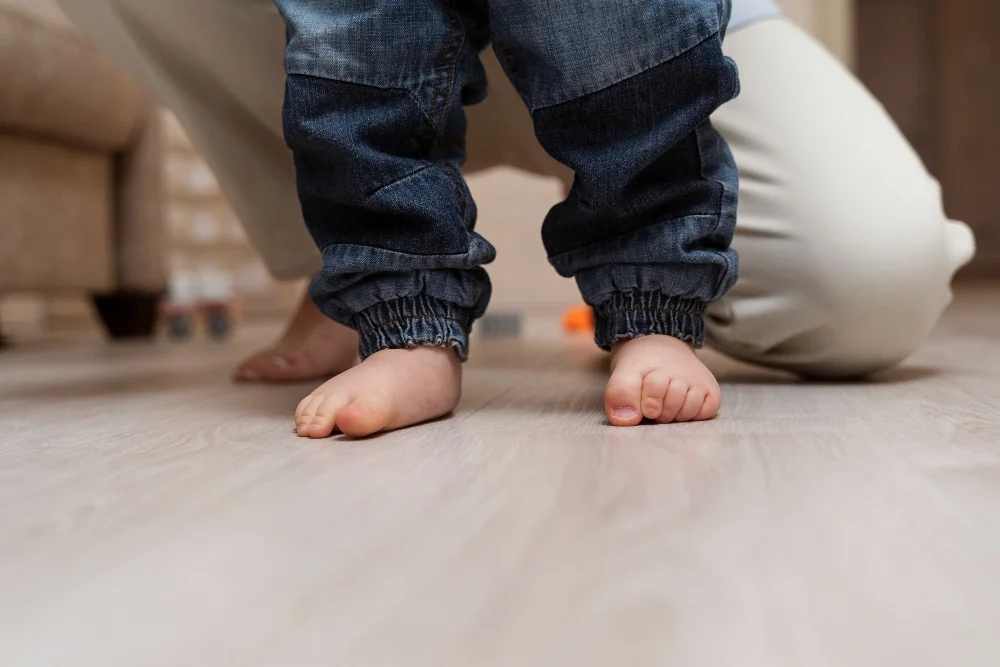Have you ever noticed your child—or someone else’s—walking on their toes and wondered whether it’s just a phase or something more? I remember asking myself the same question years ago when my niece, at around three, would sprint around the living room on the tips of her toes like a tiny ballerina. While everyone laughed, my sister quietly worried: Is this normal? Should we get it checked?
That simple concern set me down the path of speaking to paediatric physiotherapists, reading medical guidelines from the NHS, Mayo Clinic, and the American Academy of Pediatrics, and trying to understand what science actually says about toe walking. What I discovered was far more nuanced than the generic answers that dominate the internet.
This article blends real medical insights, research-backed explanations, and expert-approved facts, all in a conversational tone — so you can feel informed, reassured, and empowered to make the right decisions for your child.
Why Toe Walking Matters More Than Most Parents Realise
Toe walking isn’t always a red flag — in fact, according to the NHS, it’s common for children under the age of three to experiment with walking patterns as they develop balance and muscle coordination. But persistent toe walking beyond age three could signal an underlying issue.
What makes this topic important isn’t fear — it’s clarity. Identifying the right cause early can help support healthy development, prevent later complications, and reduce parental anxiety.
Understanding Toe Walking: What’s Normal and What Isn’t?
Toe walking simply means a child walks on the balls of their feet with their heels lifted off the ground. Many toddlers do this occasionally. Problems arise when:
- The child cannot place their heels down even when asked.
- The behaviour persists beyond age 3.
- It is consistent, not occasional.
- It appears with other developmental signs, such as delayed speech or clumsiness.
The Mayo Clinic emphasises that while occasional toe walking is harmless, persistent cases require attention because they may be linked with musculoskeletal or neurological causes.
The Most Common Causes of Toe Walking
Below are the leading causes identified by paediatric experts, physiotherapists, and major medical institutions.
1. Idiopathic Toe Walking (ITW)
Idiopathic simply means “no identifiable medical cause.”
Many children toe walk out of habit. According to the American Academy of Orthopaedic Surgeons, idiopathic toe walking is one of the most common explanations when medical evaluation shows normal muscle tone, reflexes, and neurological function.
What it looks like:
- Child can stand with heels down when prompted.
- Toe walking seems behavioural or habitual.
- No tightness or pain in calves.
Expert Insight:
The Cleveland Clinic explains that ITW often resolves naturally but should still be monitored because persistent cases may tighten the Achilles tendon over time.
Real-Life Example:
A colleague shared how her four-year-old son toe walked constantly during play but walked flat-footed at school when reminded. Physiotherapy helped retrain his walking pattern within months.
2. Tight Achilles Tendon or Calf Muscles
If the calf muscles or Achilles tendon are tight, the child might physically struggle to bring the heel down.
Signs:
- Reduced ankle mobility.
- Difficulty squatting or keeping heels flat.
- Complaints of calf discomfort.
According to the NHS, tight calves are often treatable through stretching therapy, orthotics, or targeted physiotherapy.
Expert Quote:
“We often see tightness develop in children who spend a lot of time in tiptoe play, jumping games, or even wearing shoes without adequate heel support,” says Sarah Jarvis, paediatric physiotherapist at the NHS.
3. Autism Spectrum Disorder (ASD)
Toe walking can sometimes be linked with sensory processing differences in autistic children.
Why it happens:
- Some children seek additional sensory feedback from the floor.
- Others find heel contact uncomfortable.
Evidence:
A 2021 study published in Frontiers in Pediatrics found toe walking occurs in 20–30% of children diagnosed with autism — significantly higher than the general population.
Important Note:
Toe walking alone does not indicate autism. It must be evaluated alongside behavioural, social, and communication patterns.
4. Cerebral Palsy (Specifically Spastic Diplegia)
Children with cerebral palsy may walk on their toes due to increased muscle tone or stiffness.
Indicators:
- Muscle spasticity in legs.
- Delayed motor milestones.
- Walking on toes and scissoring gait.
According to the Mayo Clinic, early physiotherapy and gait management improve long-term mobility outcomes significantly.
5. Muscular Dystrophy
This is a rare but important cause. Weakness in certain muscles — especially the calves — can lead to toe walking.
What to watch for:
- Frequent falls.
- Difficulty rising from the floor.
- Progressive muscle weakness.
The Muscular Dystrophy Association (MDA) lists toe walking as an early warning sign in certain forms such as Duchenne Muscular Dystrophy.
6. Habitual Behaviour or Sensory Preference
Some children simply prefer the sensation of walking on their toes.
Examples:
- Walking on different surfaces (carpet, cold tiles).
- Seeking height or lightness.
- Mimicking ballet or favourite characters.
Dr David Preen, paediatric consultant at Great Ormond Street Hospital, notes that sensory-driven toe walking often responds well to occupational therapy and sensory integration.
How Professionals Diagnose Toe Walking
A thorough evaluation is essential. According to the NHS and Mayo Clinic, assessment usually includes:
History & Behavioural Review
- When toe walking started.
- Whether it’s constant or intermittent.
- Developmental milestones.
Physical Examination
- Muscle tone check.
- Reflex testing.
- Range of ankle motion.
Additional Tests (if needed)
- Gait analysis.
- MRI or nerve conduction tests.
- Genetic testing (rare cases).
Expert physiotherapists emphasise that early assessment prevents complications such as tendon shortening or imbalance.
What Parents Can Do: Practical, Actionable Steps
1. Observe Patterns Carefully
Track when your child toe walks. Is it during excitement, fatigue, or all day? This helps clinicians identify the cause.
2. Encourage Flat-Foot Walking Through Play
Games like:
- “Heel race” challenges
- Obstacle courses requiring heel contact
- Walking on sand or grass
These can naturally retrain gait.
3. Try Gentle Stretching (Approved by Physiotherapists)
Daily calf stretches — especially after play — can improve flexibility.
4. Choose the Right Footwear
Physiotherapists recommend:
- Shoes with firm heel counters
- Avoiding overly soft or slipper-type shoes
5. Seek a Paediatric Evaluation if:
- The child is older than 3 and toe walks consistently.
- You notice tight muscles or awkward gait.
- There are behavioural or developmental concerns.
Evidence-Based Treatment Options
Physiotherapy
Often the first line of treatment. Techniques include:
- Gait training
- Muscle stretching
- Strengthening exercises
- Balance work
Orthotics
Heel inserts or ankle–foot orthoses (AFOs) support correct alignment.
Serial Casting
Used for tight Achilles tendons; gradually stretches the tendon over weeks.
Botox Injections
Sometimes recommended for children with cerebral palsy to reduce muscle spasticity.
Surgery (Rare & Last Resort)
Procedures lengthen the Achilles tendon when other options fail. Recommended only by specialists.
FAQs
Is toe walking always serious?
No. Many children outgrow it by age three. Persistent cases require evaluation.
Can sensory issues cause toe walking?
Yes. Sensory-seeking or sensory-avoidance behaviours can influence walking patterns, especially in children with autism.
When should I worry?
If toe walking is constant, painful, or accompanied by muscle tightness or developmental delays, seek medical advice.
Can physiotherapy fix toe walking?
In many cases, yes — especially idiopathic cases.
Do children need surgery?
Rarely. Most children respond to non-invasive interventions.
Final Thoughts
Toe walking is far more layered than many realise. While it can be harmless, it may sometimes signal underlying conditions that benefit from early support. What matters most is observation, informed decisions, and timely intervention.
If your child toe walks, you’re far from alone. With expert guidance, most children achieve a healthy, natural gait.
What Has Your Experience Been?
Do you know a child who toe walks — or did you toe walk yourself as a child? Your story might help another parent feel less alone. Share your experience or questions below!
Read Also: Best Home Physiotherapy in Faisalabad: Expert Care at Your Doorstep with Cure on Call




